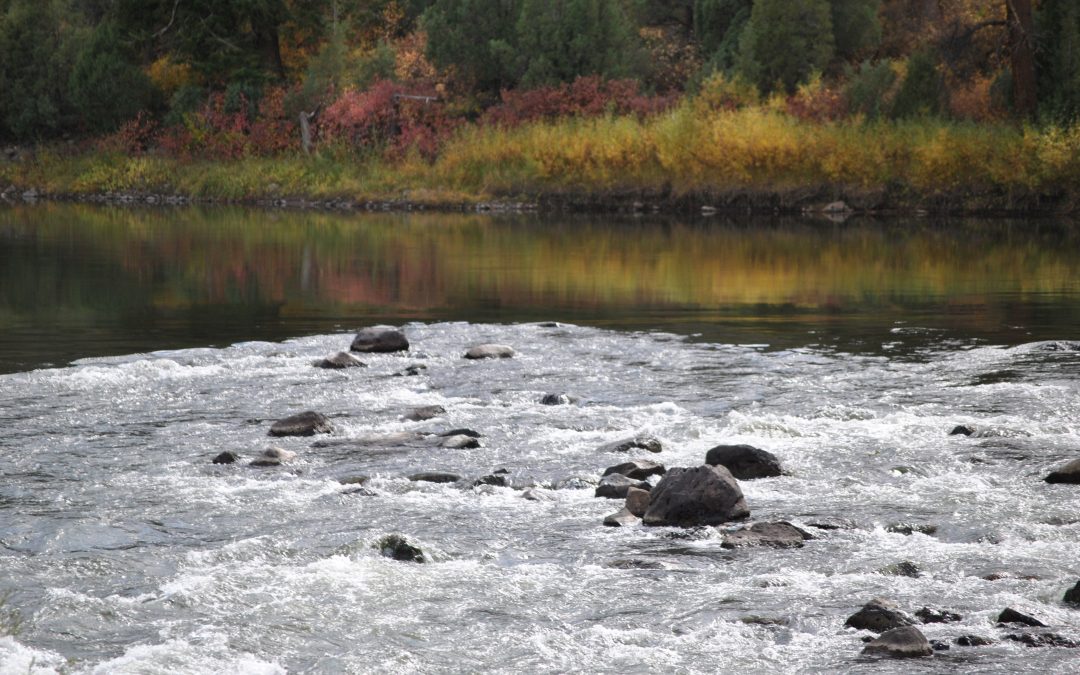By Larry Morandi

“Colorado River @ Bond Colorado” by Loco Steve is licensed under CC BY 2.0
A Denver Post article written by Jason Blevins resurrects a water issue left unresolved in Colorado for nearly 40 years. “Who owns the bottom of the river?” asks a lawsuit brought by a fisherman, Roger Hill, against a landowner, Mark Warsewa, who has blocked Hill’s access to fish on a portion of the Arkansas River near Texas Creek in Fremont County. Warsewa owns the land adjacent to the river and Hill likes to wade there after entering from public property. Warsewa claims his land ownership includes the stream bed; Hill contends the river bottom is public property. A federal district court has been asked to decide.
The basis for the suit is a body of federal law called “navigability for title,” which essentially says that if a river was used for commercial purposes at the time of statehood (Aug. 1, 1876 for Colorado), then the state owns the bed and the public has access to use the river for recreational purposes. The case—Roger Hill v. Mark Everett Warsewa and Linda Joseph—is in the U.S. District Court for Colorado because, as the plaintiff’s complaint asserts, “the question of whether the Arkansas River was navigable for title at the time of Colorado’s statehood is a question of federal law.”
Colorado has no state law defining navigability. A 1979 Colorado Supreme Court decision—People v. Emmert—ruled that a Colorado constitutional provision declaring the waters of every natural stream to be public property subject to appropriation did not grant public access for recreational use when the water flowed through private property. Violators are subject to criminal trespass. A state attorney general’s opinion four years later said that rafters would not be criminally liable, but could be subject to civil trespass. A 2010 legislative attempt to clarify the law would have allowed commercial rafters to float on waters through private property, but not fish; it passed the House but failed in the Senate.
Hill points to newspaper accounts from the 1870s that describe commercial use of the Arkansas River near Texas Creek to float logs and railroad ties. His complaint claims the river “was navigable at the time of statehood because it was regularly used and was susceptible to being used in its ordinary condition at the time of statehood as a highway for commerce, over which trade and travel are or may be conducted.” These are the essential components of the federal “navigability for title” law.
If Hill wins the case, what are the implications for rafters and fishermen on other rivers? Mark Squillace, a professor at the University of Colorado School of Law and one of Hill’s attorneys in the case, suggests that “ideally the state would set up a public process to determine which rivers are navigable for title purposes, based upon whatever test the court establishes in the Hill case. If the state fails to get out front on this issue I expect that additional litigation on other rivers would follow.”
So how have other western states addressed the public access issue? Utah’s experience is the most recent. Its legislature passed a law in 2010—Public Waters Access Act (Utah Code 73-29-101 et seq.)—in response to a 2008 state supreme court decision that granted rafters and fishers the right to use waters flowing through private property for recreational purposes and to touch the beds in a reasonable manner. The legislation both clarified and limited public access by (1) authorizing recreational use of waters that are navigable or on public property; (2) allowing rafters to float on waters through private land and touch the beds for safe passage around obstacles; and (3) permitting fishing from rafts, but not wading without permission of the landowner.
The limitations in the act led to a series of court tests and the Utah Supreme Court gave public access proponents a partial victory in November 2017 in the case of Utah Stream Access Coalition v. Orange Street Development. Like Colorado’s current litigation, the decision was limited to one river—the Weber River—and a one-mile stretch of that river. The court determined that the segment was navigable and the public had access to use it for recreational purposes, including rafting and wading.
It is interesting to note that while Colorado does not have a statutory definition of “navigable water,” Utah’s Public Waters Access Act does. It defines “navigable water” as “a water course that in its natural state without the aid of artificial means is useful for commerce and has a useful capacity as a public highway of transportation.” The Utah court found the state definition to “essentially mirror or incorporate the federal standard” (the federal standard being the “navigability for title” law in the Colorado case). Because federal law looks back to commercial activity on water courses at the time of statehood—and the court determined that historical records showed logs and railroad ties being floated on that stretch of the Weber River for commercial purposes—it confirmed the river’s navigability. The court did not address the issue of who owns the stream beds, however, because the plaintiff did not press for a title determination, just recreational access. That will likely be addressed in future litigation.
 Larry Morandi writes on environment and natural resources issues. His articles on drought, the Colorado River and public access to water have appeared in State Legislatures magazine. He recently retired from the National Conference of State Legislatures, a think tank based in Denver, where he was Director of State Policy Research. He previously worked for the Colorado Legislative Council as staff to water committees. Larry has lived in Colorado for the past 40 years, splitting his time between Denver and Summit County.
Larry Morandi writes on environment and natural resources issues. His articles on drought, the Colorado River and public access to water have appeared in State Legislatures magazine. He recently retired from the National Conference of State Legislatures, a think tank based in Denver, where he was Director of State Policy Research. He previously worked for the Colorado Legislative Council as staff to water committees. Larry has lived in Colorado for the past 40 years, splitting his time between Denver and Summit County.


 Print
Print
Reblogged this on Coyote Gulch.